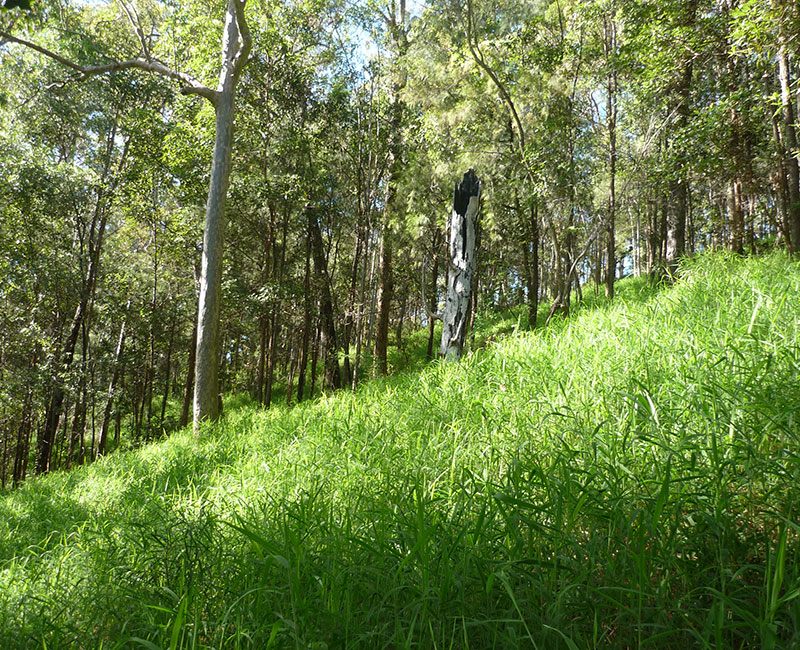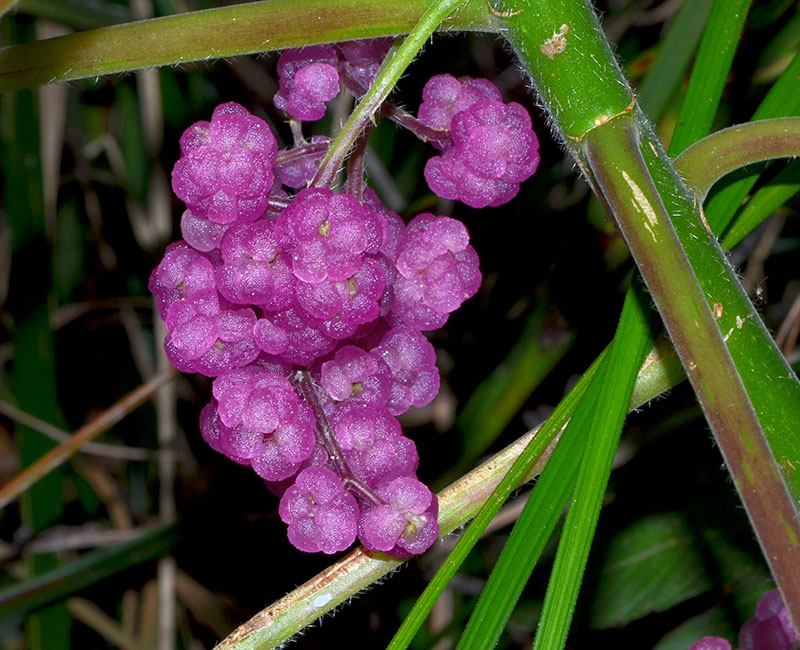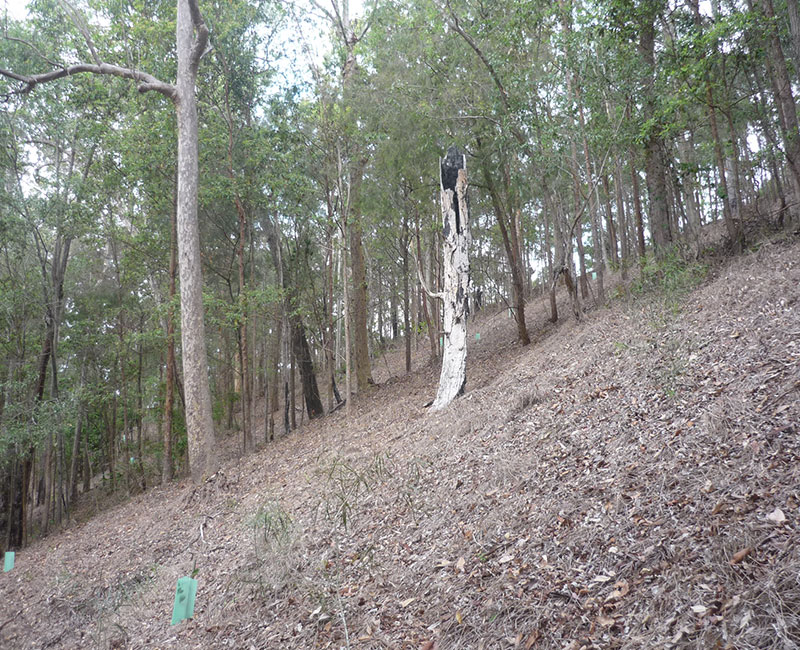Above: Barbed Wire Vine (Smilax australis) in flower.
What joy forest life here brings to inspire this little bush restorer! Whether it be the sense of magic that fireflies bring just on dark in the early spring or the delightful sight of Noisy Pittas, Paradise Riflebirds and Regent Bowerbirds visiting for the winter, my passionate connection with the environment here drives a strong and determined spirit towards restoring degraded and weedy areas. I love the
rich ashes of colour up in the canopy of Richmond Birdwing butterflies hovering around their territory, or spotting a sleepy Koala’s legs dangling from a comfy crook in a spotted gum, or the uniquely eerie call (scream!) of the Sooty Owl.
These days this beautiful 24 hectare bushland estate in Tallebudgera Valley that I call home is an important link in the east-west Burleigh to Springbrook bioregional corridor and shares a boundary with the City of Gold Coast’s Trees Road Conservation Area. The fragments of blue plastic I see all though the gully suggest that its past includes a period of banana farming after it was logged perhaps 60 years ago.
I have always been a pretty keen weeder in my 16 years here. Eight years as a carer for Wildcare and my work at Bush Nuts Native Nursery has raised a concerned awareness in me of the responsibility we have in valuing and protecting the biodiversity here and I was thrilled when the estate finally joined the wonderful Land for Wildlife program four years ago.
My mission really stepped up with the discovery of Cat’s Claw Creeper which was invading the northern gully and threatening the area’s native vegetation, including Richmond Birdwing butterfly habitat. The cat’s claw took hold maybe 20 years ago (I’ll never forget the day I spotted its lovely yellow flowers from the veranda!). The main infestation was about a quarter of a hectare in size so I felt confident that with a little help from friends I could knock it!
We started out by cutting off all the vines climbing up the trees and then treated the cut vines at ground level using the cut, scrape and paint method. Then I foliar sprayed the ground mass monthly with a glyphosate/metsulfuron methyl mix and a wetting agent (Pulse® Penetrant) until it thinned out. I was so frustrated when the tubers kept re-shooting, but I persisted with monthly foliar spot spraying and four years on, we’re almost there! I prefer to dig out the last of those stubborn tubers by hand (enough spray I say) and will need to be on high alert for a few years yet to ensure this serious weed is completely eradicated.
For the last three years I have received funding through the City of Gold Coast’s Nature Conservation Assistance Program (NCAP). I feel so fortunate in receiving the funding; such wonderful support has enabled me to hire a great team of restoration contractors and drives a real incentive to succeed in restoration efforts.
The current project area is about 5.5 hectares and predominantly involves eradicating Molasses Grass in Koala habitat as well as managing cat’s claw, lantana, Camphor Laurel, Tobacco Bush, Brazilian Nightshade, White and Corky Passionfruit, Ochna, Crofton Weed and Broadleaf Paspalum in the northern gully.
The Molasses Grass that dominated the northern eucalypt slopes was up to two metres high. It is an easy weed to kill and was initially foliar sprayed by the contractors. Then I did follow up spot spraying and hand weeding; and now, 15 months later, it continues to serve as a protective layer of mulch for the soil as native groundcovers and grasses slowly start emerging again.
In the gully area the lantana is either being lopped and reduced to mulch (with their stems cut, scrape and painted) or where there aren’t any natives amongst it, over- sprayed, leaving skeletal patches that continue to provide habitat for many small creatures until the lantana breaks down.
As frustratingly dominant as Camphor Laurels are in the landscape, there is evidence that they have played a role in regeneration here. I have observed many native species such as Red Kamala (Mallotus phillipensis), Red Bean (Dysoxylum mollisimum), Creek Sandpaper Fig (Ficus coronata), and Native Ginger (Alpinia caerulea) establishing underneath many Camphor Laurel trees. In autumn, when they are fruiting, the camphors attract many frugivores (including Topknot Pigeons, Green Catbirds, Olive-backed Orioles and Australasian Figbirds), which disperse native seed from nearby forests.
In recognition of the role they play, I am wary not to open up the camphor canopy too soon and choose carefully which ones to target for stem-injection over the next few years.
My first attempt to stem-inject a camphor tree was an exhausting disaster as I had the wrong drill bit! I am thrilled to report that my new super turbo screw drill bit does the trick.

Molasses Grass dominated this hillside preventing Koalas from moving around freely.

The bright purple fruit of Gympie Stinger (Dendrocnide moroides).

18 months later, the same hillside has had all the Molasses Grass removed allowing native ground cover plants to grow.
When I cut and scrape weeds I use a small hand pump in the form of an old hair spray bottle (atomiser), which sits well in my tool holster. For me it’s easier than painting with a poison pot, the only disadvantage being that you need to hold it upright to apply.
With concerns around the changing climate, I decided to plant some fast growing species. The species I planted are found in the small remnant and regrowth rainforest nearby so I know that they’re appropriate choices. They include Native Frangipani (Hymenosporum avum), Brown Kurrajong (Commersonia bartramia), Brittlewood (Claoxylon australe), White Cedar (Melia azedarach), Celerywood (Polyscias elegans) and Red Cedar (Toona ciliata).
I have also sporadically planted some secondary species that are found in the small but amazingly diverse nearby remnant, such as Silver Leaf (Argophyllum nullumense), Marblewood (Acacia bakeri), Muskwood (Alangium villosum), Finger Lime (Citrus australasica), Glossy Laurel (Cryptocarya laevigata), Gympie Stinger (Dendrocnide moroides), Black Walnut (Endiandra globosa), Winged-leaved Tulip (Harpullia alata), Fine-leaf Tuckeroo (Lepiderema pulchella), Fissistigma (Meiogyne stenopetala), Veinless Mock-olive (Notelaea johnsonii), and Veiny Wilkiea (Wilkiea huegeliana).
Access to the gully site is a steep descent, giving it a secluded garden feel where Richmond Birdwing butterflies glide about in the warmer months and Eastern Yellow Robins and Rufous and Grey Fantails always flit around. They are wonderful company for me as I work (about eight hours a week) and dream of a beautiful future for many vulnerable species.
I think that Mother Earth doesn’t deserve too much spraying, thus I choose to do a lot of hand weeding, especially through emerging native grasses and all those delicate lovelies such as Darling
Pea (Swainsona galegifolia), Tripladenia (Tripladenia cunninghamii), Love Flower (Pseuderanthemum variabile), Small- owered Geranium (Geranium homeanum), Maidenhair (Adiantum spp.) and Forest Lobelia (Lobelia trigonocaulis).
I have a particularly challenging relationship with a dear Swamp Wallaby. I am sure her chomping and snapping of young saplings is in protest of the gradual disappearance of her lovely soft beds of Broadleaf Paspalum. Eucalypts, Poison Peach and Native Mulberry are some of her favourite flavours. She loves to check out what’s on offer inside those tree guards so I’m not really sure if they serve much purpose, but they seem to offer a more favourable micro-climate in dry weather.
And so, time and body permitting, I’ll keep lovingly tending every precious little native sprout towards forest healing. And when that day comes when I have to leave, I will get someone to set up a kind of bird drone or wallaby poo cam in that forest, wi-fi it up to my virtual goggles, and I will settle back in a comfy chair with my handy remote and take a walk through that special forest that I learnt so much from during my journey in restoration.
Article by Michelle Benson Land for Wildlife member Tallebudgera, Gold Coast
